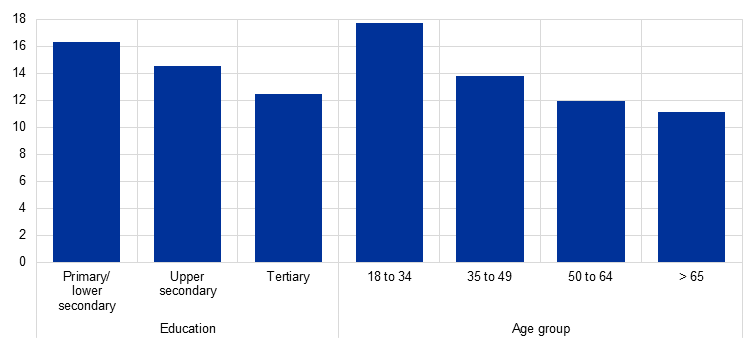Published as part of the ECB Economic Bulletin, Issue 7/2024.
Understanding how consumers perceive drivers of inflation is crucial for interpreting shifts in their inflation expectations, which can significantly influence real economic decisions. The narratives consumers construct to explain inflation play a key role in shaping their expectations, with different drivers – such as wages or profits – implying different degrees of inflation persistence.[1] To explore this further, in June 2023 and March 2024 the ECB’s Consumer Expectations Survey (CES) asked consumers to select what they thought had been the main driver of the 2022-23 surge in inflation from three answer options: firms’ profits, wage costs, or other input costs. While consumer perceptions shifted, notably in the lead-up to early 2024, they have since stabilised, making the March 2024 survey data indicative of broader trends. Analysing these evolving perceptions helps explain adjustments in inflation expectations and how shifts in macroeconomic narratives affect inflation dynamics going forward.
In March 2024 most consumers in the euro area attributed the 2022-23 surge in inflation mainly to (other) input costs, followed by profits and wages. Panel a) of Chart A shows the percentages of respondents selecting each option for each country. Other input costs (e.g. energy, raw materials or other business costs) was selected as the main driver by 66% of euro area respondents, followed by firms’ profits (20%) and wages (14%). While this ranking of inflation drivers was common across individual countries, there was considerable variation in the frequency of each answer. The order of the countries is based on the percentage of respondents selecting wages as the main driver. The Netherlands (27%) and Belgium (22%) lead this ranking, with Austria (19%) and Germany (17%) following closely behind, and France (9%), Finland (8%) and Greece (8%) at the bottom. In Greece, a noticeable percentage of consumers (43%) believe firms’ profits were the main driver of inflation.
Chart A
Perceived main driver of inflation
a) By country
(percentages of respondents)

b) Change between June 2023 and March 2024
(percentage point changes; annual percentage changes)

Sources: ECB Consumer Expectations Survey (CES), Eurostat and ECB calculations.
Notes: Panel a): Weighted estimates. Percentages of respondents selecting each option per country in March 2024. The question in the CES reads as follows: “According to your view, what is the main factor driving the change in the general level of prices for goods and services in your country during the past 12 months”. The answer options were: “1. The main driver is firms’ profits; 2. The main driver is wage costs for firms; 3. The main driver is other input costs for firms (e.g. energy, raw materials or other business costs)”. Panel b): The bars refer to weighted estimates of the change in the percentages of respondents selecting each answer option between June 2023 and March 2024. The coloured points refer to the annual percentage changes in the second quarter of 2024 for unit labour costs, energy inflation and unit profits, as derived from official data.
Compared with June 2023, consumers’ perceptions of the main drivers of inflation shifted towards wages, although other input costs were still seen as the strongest driver overall. The question on the perceived main driver of inflation was first posed in the June 2023 CES and repeated in the March 2024 CES.[2] Panel b) of Chart A shows the change in the percentages of respondents selecting each answer option between June 2023 and March 2024 for the euro area as a whole. The percentage of consumers selecting firms’ profits decreased by 5 percentage points, while the percentage selecting wage costs increased by 6 percentage points. This is in line with developments in wage growth and unit profits over the same period. The percentage of respondents selecting other input costs remained broadly constant, changing only by less than 1 percentage point.
Chart B
Wages as the main driver of inflation
a) By respondent educational level and age
(percentages of respondents)

b) By country and wage growth level
(percentages of respondents; annual percentage changes)

Source: ECB Consumer Expectations Survey (CES).
Notes: Weighted estimates. Percentage of respondents selecting wages as the main driver of inflation per country in March 2024. Negotiated wages refers to the annual growth rate, including one-off payments, for the first quarter of 2024.
Consumers selecting wages as the main driver of inflation are generally younger, without a college degree and live in countries where wage growth has been relatively high in the past year. Panel a) of Chart B shows the prevalence of wages as the main driver of inflation according to educational level and age. A possible explanation for this finding is that recent wage growth has been particularly strong among minimum-wage employees, who typically have a lower level of education and are in the younger age group. Furthermore, in countries where past wage growth has been high, a greater proportion of respondents tend to select wages as the main driver of inflation (Chart B, panel b).
Changes in consumer perceptions of the main drivers of inflation follow recent developments. Wages have gained more weight in their perceptions, while the role of profits has waned, in line with recent developments in wages and unit profits. Such changes demonstrate how narratives about inflation are reflected in consumer perceptions of the main drivers of inflation, which, in turn, may affect how they form their inflation expectations. This therefore highlights the importance of monitoring shifts in inflation narratives.
For empirical evidence, see Andre, P. et al., “Narratives about the Macroeconomy”, Discussion Paper, No 17305, Centre for Economic Policy Research (CEPR), May 2022.
The findings from the June 2023 CES are presented and discussed in the box entitled “What do consumers think is the main driver of recent inflation?”, Economic Bulletin, Issue 6, ECB, 2023.







